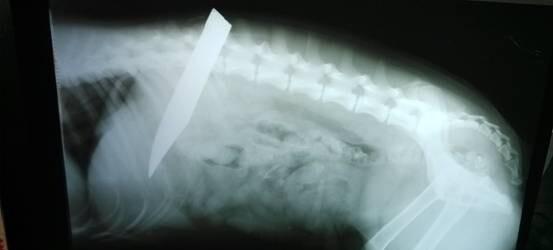Dog trauma is common in clinical practice, mainly caused by animal-to-animal bites, car accidents and other reasons. Since the occurrence of trauma is not the same, this paper only takes a case of dog knife wound treatment as an example.
I. Diagnosis process of dog knife wound treatment
1. Consultation
Inquire in detail the reasons for the occurrence of animal wounds, whether it is caused by fighting between animals or other reasons; the recent mental and appetite status of the animals themselves
2. Basic physical inspection
Perform other tests such as breathing, pulse, temperature, lymph nodes, etc.
3. Basic blood index test
Including blood routine, serum biochemistry, blood gas, blood smear and other tests.
4. Other inspections
X-ray B-ultrasound to determine the location of the wound, and the depth of the wound
2. Treatment
The wound can be clearly seen on the picture, as well as the knife left on the outside

X-ray lateral view, depth of knife penetration
X-ray ventral dorsal exploration knife penetration depth and width
After examination, after anesthesia and skin preparation, the skin was incised from the incision position to explore the position where the knife was inserted, and it was seen that the knife penetrated into the stomach, and there was an incision in the stomach.
Continuing to explore, it was found that the incision had penetrated into the spleen. After the blade was gently taken out, the spleen was turned over and an incision above the spleen was found, so it was decided to perform splenectomy.
Resected spleen and knife
III. Splenectomy
1. Indications for total splenectomy
Spleen tumors, torsion, or severe trauma to the spleen may require surgical removal of the entire spleen.
2. Partial splenectomy
For animals with partial spleen damage or trauma, local splenectomy is required in order not to affect the normal function of the spleen.
3. Postoperative care
After splenectomy, the sick animals were closely monitored for postoperative bleeding within 24 hours.
4. Complications
The most common complication of spleen surgery is postoperative bleeding, and animals with preoperative immunosuppressive disease are at higher risk for significant septic sepsis following splenectomy.
5. Precautions for animals of special age
Splenectomy is usually performed in middle-aged and elderly animals.
